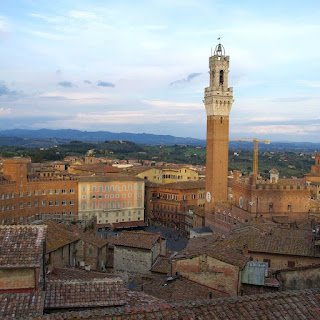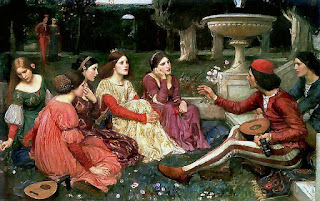During his lifetime,
Dante Alighieri was embroiled in
Florentine politics, but along the way he found time—well, he was in exile and had leisure time he would not have had if he had remained a politician in Florence— to write a masterpiece of medieval poetry. He called it the
Commedia, and it has three parts:
Inferno,
Purgatorio, and
Paradiso.
The work is made of 100 canti, a one-canto introduction and three sections each with 33 cantos, representing (I assume) the 33 years of the life of Christ. It is written in a three-line scheme called terra rima, and runs ABA BCB CDC DED, with lines of 11 syllables each. Therefore, each three-line section in each canto is also 33 syllables.
Numbers remain important in the "geography" of the afterlife. Each of the three parts of the afterlife nine levels, plus one "climactic" level. Nine rings in Hell and then Lucifer at the very bottom, nine levels climbing Mount Purgatory with the Harden of Eden at the summit, nine areas of Heaven plus God at the top.
Written in Tuscan Italian, its popularity helped establish that dialect as standard Italian. The poem also offers us a view of the world and afterlife that is representative of its time. The story is framed as a pilgrimage by the narrator, Dante, who is given a tour of the three realms of the afterlife.
There are three tour guides in this pilgrimage. Taking him through Inferno, Hell, and part of Purgatorio, Purgatory, is Virgil. Not only was Virgil a respected Roman Piet whose works were admired by Dante, but also he was considered to be a "Christian prophet" of sorts because one of his writings was interpreted by St. Augustine and others as a predictor of Jesus Christ. He was considered a "virtuous pagan" by the Christian Middle Ages. From the Inferno we get the notion of the several layers of Hell going deeper as the sins get worse.
While in Purgatory, Virgil hands the narrator off the Beatrice, Dante's childhood friend and first and greatest love whom, as an adult, he had not seen in years. She represents divine revelation, and shows him the souls whose failings are not so great that they cannot eventually gain Heaven.
When he reaches Heaven, Paradiso, his guide is none other than St. Bernard of Clairvaux, who represents contemplative mysticism and devotion to the Virgin Mary.
He includes many real historical figures in the Commedia, especially those whom he considered his enemies while they were alive. In Purgatory he sees Mechthild of Magdeburg, Peter Damian, Manfred of Sicily, Frederick II, Pope Boniface VIII, Michael Scot, Peire d'Alvernhe, and many others.
Dante merely called his great work Commedia, but an admirer and biographer (and a poet in his own right), Giovanni Boccaccio, added the adjective "Divine," which stuck. Boccaccio, along with Dante and Petrarch, forms the peak of medieval Italian literature, and we'll take a better look at him tomorrow.









.png)

















